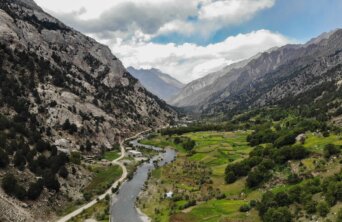- About
- Topics
- Picks
- Audio
- Story
- In-Depth
- Opinion
- News
- Donate
- Signup for our newsletterOur Editors' Best Picks.Send
Read, Debate: Engage.
| topic: | Natural disaster |
|---|---|
| located: | Afghanistan |
| editor: | Shadi Khan Saif |
The recurrence of flash floods wreaking havoc in the countryside across northern and eastern Afghanistan highlights the vulnerabilities faced by the population in the face of a destructive combination of climate change impacts and internal state failures.
The ongoing loss of life and property damage can be prevented through effective governance measures at the local level, as well as concerted global actions to mitigate greenhouse gas emissions and combat the warming of the planet. Unfortunately, the Afghan people find themselves helpless on both fronts, lacking the necessary support and resources to tackle these challenges effectively.
In the past week, several provinces in Afghanistan witnessed devastating flash floods that swept away entire settlements and claimed dozens of lives. The floods struck after a prolonged drought, and the financial losses incurred by the affected villagers are overwhelming, as their crops and livestock were destroyed.
It is important to recognise that farming communities eagerly anticipate reaping the rewards of their year-long hard work in the fields. In this unfortunate scenario, where the floods have washed away everything, the consequences extend to at least two years of disparity, further deepening the hardships faced by these communities.
Locals in Afghanistan - a mountainous country - are no strangers to the occurrence of flash floods during the summer. But the recent floods have brought about a level of destruction that surpasses what the communities are accustomed to.
Since the US withdrawal two years ago, local communities across Afghanistan, particularly village farmers, have been largely cut off from the rest of the world. As a result, they have limited access to information and understanding about the underlying causes behind the accelerated glacier melt and unpredictable rainfall patterns that have led to unusually severe and deadly floods.
The previous Afghan state had initiated some measures to protect communities from the hazards of natural disasters like flash floods. However, since the Taliban takeover and the subsequent lack of international support, these efforts have experienced a significant setback.
Two years ago, before the fall of the Republic, Afghanistan had several promising projects aimed at mitigating the hazards of floods and protecting communities. These initiatives included the construction of trenches in the hills to preserve water, the establishment of small check-dams and efforts towards forestation. These projects held great potential in terms of safeguarding communities from flood-related risks. Additionally, there were plans to undertake large-scale reforestation across the country's mountainous regions, which would have not only helped prevent floods but also contributed to cleaner air and other environmental benefits.
These projects were abandoned, however, following the Taliban takeover and a decline in foreign donations. Ever since, Afghanistan seems to be steadily regressing to 19th century living conditions despite years of generous international support and local sacrifice and ingenuity.
The Green Climate Fund and other support channels have an important role to play in assisting the Afghan people, particularly in the context of climate change and environmental challenges. It is crucial that humanitarian aid and support are provided to the Afghan population without further complicating the situation with the current Taliban regime and international sanctions.
As the second anniversary of the fall of the Republic in Afghanistan approaches, it is crucial for the international community and the humanitarian world to recognise their moral responsibility in not abandoning or ignoring the plight of this beautiful country and its people.
Image by Sohaib Ghyasi.
